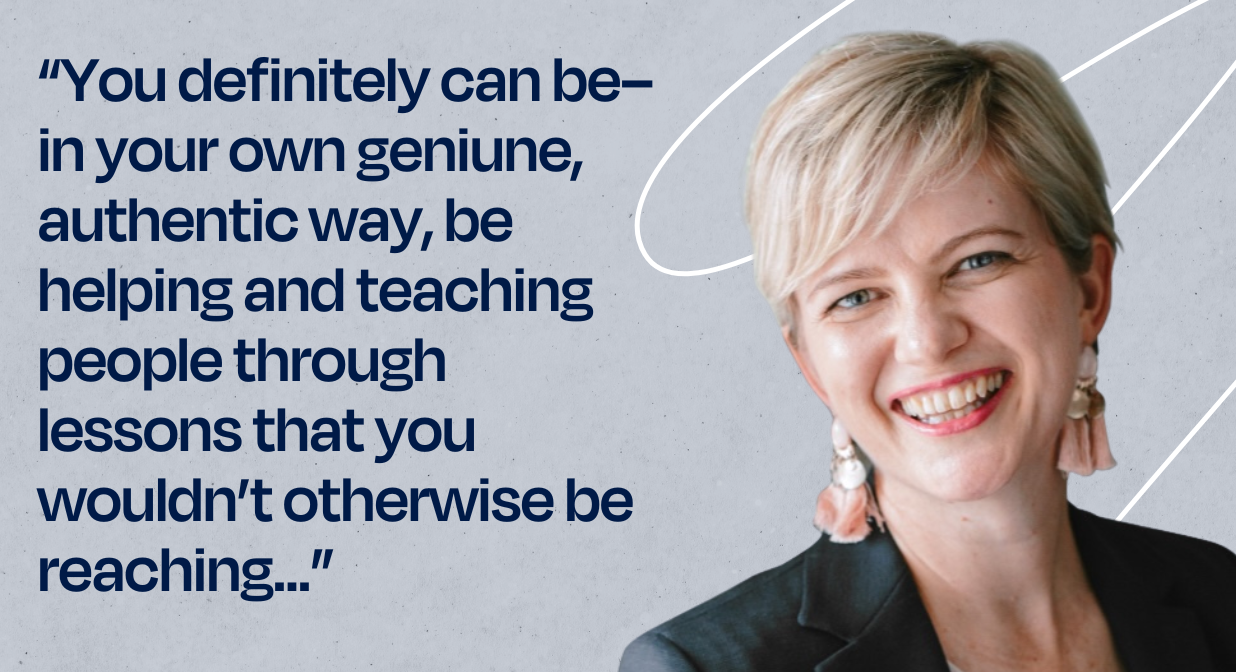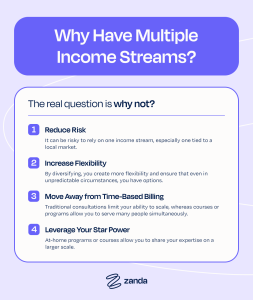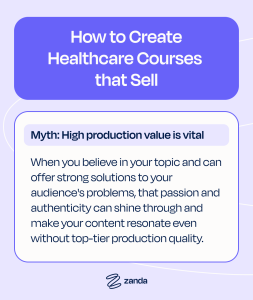The healthcare industry is always changing, which is why many allied health professionals choose to expand beyond traditional service offerings to stay competitive.
One effective way to do this is to create and sell healthcare courses, which allow you to share your expertise with a wider audience and generate additional income.
In a recent webinar, Megan Walker, Director of MeganWalker.com, and Damien Adler, Co-Founder and Head of Customer Success at Zanda (formerly Power Diary), explored how healthcare professionals can diversify their services and build profitable courses.
In this summary of Megan and Damien’s conversation, you’ll discover how to diversify your product offerings and income streams for long-term success. We’ll walk you through the most common barriers healthcare professionals face when crafting courses – and show you how to overcome them.
Megan, with over 25 years of experience working with healthcare practices, specializes in automating marketing through AI and guiding professionals in launching successful courses.
Damien, drawing from his background as a psychologist and former private practice owner, now helps allied health clinics grow through technology and streamlined practice management.
Why Have Multiple Income Streams?
The real question is why not?
Reduce Risk
It can be risky to rely on one income stream, especially one tied to a local market. Increased competition in your area could squeeze your practice, while niche opportunities and audiences beyond your immediate reach, nationally or even globally, remain untapped.
Increase Flexibility
By diversifying, you create more flexibility and ensure that even in unpredictable circumstances, you have options. Passive income for therapists offers freedom over how they work and provides ways to continue their service to clients or patients.
Move Away from Time-Based Billing
Another reason to branch out? Time is finite – you can only sell it once. Traditional consultations limit your ability to scale, whereas courses or programs allow you to serve many people simultaneously, which will increase your revenue without sacrificing more hours.
A diversified income also helps break the monotony of repetitive tasks. Instead of going over the same advice or exercises with each patient, at-home programs or “homework” solutions can automate parts of advice or exercises that can become repetitive with one-on-one sessions.
Leverage Your Star Power
At-home programs or courses allow you to share your expertise on a larger scale. However, you should protect your energy when developing these products. If you’re burnt out or overwhelmed, it will show in the content, so pace yourself and create courses when you’re at your best.
How to Choose a Profitable Topic
The right course topic can be the difference between a profitable venture and one that falls flat.
To get this right, think of it like a Venn diagram. Megan uses this approach to help professionals find the sweet spot where their expertise, audience needs, and market demand overlap. At the intersection of these areas is where your course will provide real value.
Another tool to consider is the quadrant diagram, which highlights two key factors: your target audience and their willingness to pay. The audience you’re targeting must be large enough and ready to invest in a solution to its problem. Ask yourself: What is the pain point they need to fix? How can your expertise directly address and solve this issue?
Your course must be designed to offer a clear solution. Look for areas where your skills can be a “wedge under the table” – solve an urgent problem that your audience can’t ignore and is willing to pay for. Whether you’re addressing chronic pain management, mental health strategies, or practical skills for fellow practitioners, identify a pressing need in a large enough market and craft your course around fixing that issue.
The Secret to Presenting Well
The way you present your course is just as important as the content itself.
To truly connect with your audience and keep them engaged, three key qualities are essential:
True belief in your topic
Your passion will be contagious.
If you deeply believe in the value of what you’re teaching, your audience will feel it, too. Think of it like a respiratory physio student passionately explaining how correct breathing techniques can transform a patient’s life – it’s this kind of energy that makes your message stick.
Deep Authenticity
People can tell when someone is being genuine versus when they’re being “sold to.”
Authenticity builds trust and credibility, which will make your course feel like a solution rather than a mere product. Be yourself, speak naturally, and let your true personality shine through.
A Strong Solution
Belief in your offering and authenticity are crucial, but your course also needs to offer real, tangible value.
If you can confidently present a strong solution to your audience’s problem – something they’re eager to pay for – then your delivery will come across well.
Sound Quality
Details matter. When it comes to video production, don’t worry too much about having a perfect background.
Good sound quality, however, is non-negotiable. Clear audio ensures your message will be heard loud and clear, keeping your audience engaged and reducing distractions.
Phase 1: Webinar Series/Free Event
In the first phase of creating a successful course, start small.
Just like comedians test their material in smaller venues before polishing it for a big special, you can host a webinar series or free event to test your ideas with real audiences and gather invaluable feedback. This will help you refine your content before you launch a full course.
When you start out, you’ll likely have two main audiences:
- Peer-to-peer audience: This audience usually comprises your colleagues or other professionals in your field. You can get direct feedback from people who understand the subject matter, and their insights can help you fine-tune your future course topics and improve your material based on what resonates most with this informed group.
- Potential clients: Free events are a great way to attract potential customers who may eventually convert into paying clients. Offer a free taste of your expertise to gather a larger, more diverse audience. As you engage with them, you’ll get to try different approaches and topics and create a continuous feedback loop that helps shape your future offerings.
Building a successful course takes time, research, and patience. It likely won’t become an overnight viral sensation.
Instead, focus on improving your content step by step. Over time, this testing and refinement process will funnel into a polished product that’s ready to scale.
Phase 2: Mini-Course
Once you’ve tested the waters with webinars or free events, the next step is to create a mini-course.
This mini-course should be short and focused; think of it as approximately four lessons, each about 10 minutes long. The goal here is to give your customers a quick win by solving one specific problem.
A mini-course is a great way to introduce clients to your business with a low barrier to entry. It’s easy for them to commit to, and once they see results, they’re more likely to trust you and engage further with your offerings.
Plus, it can help cover your promotional costs and bring new clients into your funnel, creating a steady flow of potential future customers.
Your mini-course will also provide a vital feedback loop that you can use to refine and improve future courses. It’s the perfect way to get started as a course creator – small, manageable, and filled with learning opportunities that will set you up for success in the future.
Phase 3: Signature Course
With the momentum from your mini-course, the signature course is where the real transformation happens. This is the next step for clients who experience success with your mini-course and are ready for an in-depth, more comprehensive journey.
Here, you’ll expand on the solutions introduced in the mini-course and provide a more thorough, in-depth look at how to tackle your audience’s pain points. This is where you take your clients beyond quick wins and guide them toward long-term results and meaningful change.
By this point, your audience is likely primed to trust you, and the signature course is the logical next step to help them achieve more significant, lasting outcomes. This is where engaged clients become loyal advocates.
Unlearning How You Were Taught
To create a healthcare course, it’s essential to break away from traditional academic teaching methods that may not suit your audience’s needs.
For example, starting with a literature review might be appropriate in a university setting, but in a practical, results-driven course, it can overwhelm or bore your audience.
If you’re teaching something simple, like a breathing technique, do you really need to dive into a long-winded literature review first? Probably not.
There’s a big difference between how you were taught in formal education and how you should teach when your audience requires quick, actionable solutions.
Time to Value
How long does it take for your audience to benefit from what you’re saying?
Unlike university students tied into years of study, busy professionals don’t have the luxury of time. They need fast results.
Get straight to the point and skip the long-winded setup. Deliver value early, and keep the focus on practical takeaways that they can immediately apply to their work or personal lives.
What’s the Intent of Your Product? What Problem Does Your Product Solve?
Clarify the Intent of Your Product
Your ultimate goal should be to move your students from Point A (where they are) to Point B (where they want to be). Does your content effectively facilitate this shift? If there’s no defined Point B, you risk creating a course that fails to motivate students to complete it.
Ask yourself these questions:
- What specific problem does it solve?
- How does it help your students progress?
Leave your audience wanting more
When students are at Point A, they may want to learn or improve.
However…
…by the time they reach Point B, they should need what you have to offer.
This strategy ensures they feel engaged and satisfied, setting the stage for future courses and keeping the enthusiasm alive as they progress through their learning journey.
Barriers to Success
Delayed Content Creation
Delayed content creation is often rooted in procrastination, which can be fueled by fear of failure and judgment. This is an experience many self-aware professionals will understand, and many aspiring course creators find themselves stuck in a cycle of inaction, frozen by worry about how their work will be perceived.
Solution
Timeboxing helps you set aside dedicated blocks of time to focus on content creation.
By breaking down the task into manageable chunks, you can overcome the urge to procrastinate and make steady progress without feeling overwhelmed.
Imposter Syndrome
You might think, “Why would anyone listen to me?”
This self-doubt can lead to an overwhelming fear of judgment–not just from peers, but from your own inner critic.
Remember, most people are more concerned about their own fears and anxieties than they are about judging you.
Solution
Recognize that you have a limited window to make an impact.
If not now, when?
Consider how you would feel if you remained silent while having the power to help others. Your insights and experiences are valuable, and sharing them can create meaningful change.
Integrate Courses into Your Practice
Craft a strategy that helps you seamlessly integrate your courses into your existing services and enhance your offerings and clients’ experiences.
What Tech Do You Need?
The technology you choose to launch your course can have a big impact on the user experience.
Prioritize how your content is delivered to ensure that it’s not just a collection of files dumped into a Google Drive. Think about creating a cohesive experience that keeps your learners engaged and motivated.
Ultimately, the right technology will enhance your audience’s experience and ensure they can easily navigate your course.
Mobile-friendly
First and foremost, your platform should be mobile-friendly.
Many users will access your courses on smartphones or tablets, so it’s wise to ensure a seamless mobile experience.
Progress Features
Consider incorporating features like built-in certificates or badges for course completion. This can motivate learners and give them a sense of accomplishment. It also provides a visual representation of subscribers’ progress and encourages continuation through the course.
Kajabi
Kajabi is a popular website builder and learning management system that streamlines course creation. Kajabi provides an intuitive interface for building your site and helps reduce the risk of user and password sharing, which will keep your content secure.
WordPress
If you’re already using WordPress for your main website, you can integrate it with platforms like LearnDash, Thinkific, or Searchie.
These tools allow you to create an organized and engaging learning environment while leveraging the power of WordPress.
What to Include in Your Offer
A compelling course involves more than just delivering content; it’s about creating a well-rounded offer that meets the diverse needs of your audience.
Here are some key components to consider:
Optional Facebook Group/Community
Building a sense of community around your course can enhance the learning experience. An optional Facebook group allows participants to connect, share insights, ask questions, and support each other as they progress.
This creates a more engaging and interactive environment, making learners feel less isolated.
Course + Coaching
Pair your course with coaching sessions to add value.
While your course provides essential information and skills, coaching offers personalized support and accountability. This combination ensures that participants can apply what they’ve learned effectively and receive guidance tailored to their specific challenges.
Membership/Subscription Model
Consider offering a membership or subscription service, where learners pay a recurring fee for ongoing access to content, resources, and community support.
This model can create a steady income stream while keeping your audience engaged with fresh material and updates.
Mini-Course + Signature Course + Membership
Think about structuring your offerings as a learning journey.
Start with a mini-course that serves as an easy introduction to your content. This lower-barrier option can attract potential clients who may be hesitant to commit to a more extensive program. Once they see the value, they can transition into your signature course and ultimately join a membership for continued learning and community support.
Top 5 Myths Busted
As you embark on your course creation journey, let’s dispel some common misconceptions that may hold you back.
Myth 1: Passive income for therapists means overnight success
The idea of earning passive income from courses often leads to the belief that it will happen quickly and effortlessly.
In reality, building a successful course takes time, dedication, and consistent effort. It’s about creating quality content, marketing effectively, and nurturing your audience over time.
Myth 2: I’ll just sell to my existing clients
While your current clients may be a good starting point, if you rely solely on them, you’ll limit your potential.
You might find that your existing client pool is too small or consists of clients who aren’t seeking new offerings. Expand your reach to attract new audiences.
Myth 3: There’s already enough free information on YouTube
A wealth of free information is available online, but many people prefer curated, expert-led content that provides structure and clarity.
Your unique voice, style, and expertise can offer something more valuable than random YouTube videos.
Myth 4: If I’m charging them, I should give them everything
Many creators believe that charging for their content should provide exhaustive information.
The truth is your audience is often looking for brevity and focus. They want the best insights delivered concisely, so they can gain maximum value in the shortest amount of time.
Myth 5: High production value is vital
When you believe in your topic and can offer strong solutions to your audience’s problems, that passion and authenticity can shine through and make your content resonate even without top-tier production quality.
Ready to take the leap into course creation?
Megan Walker’s extensive experience in helping healthcare professionals succeed can help your course stand out in a crowded marketplace.
For more information, insights, and personalized support, you can reach Megan at www.meganwalker.com.
Plus, grab the Free Guide on her website, “10 Ways a Healthcare Course Will Save You Time and Make You Money.” This guide is packed with actionable insights to kickstart your course creation journey.
Embrace the opportunity to diversify your income, share your expertise, and make a meaningful impact on your audience. With the right guidance and tools, you can turn your knowledge into a successful course that not only boosts your bottom line but also helps others thrive.







